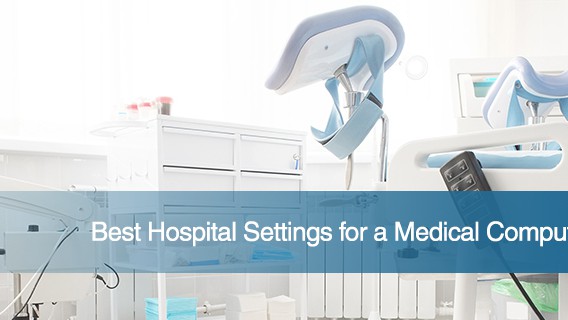When deciding what type of personal computer is right for you, whether it’s for an industrial, medical, or enterprise application, one of the decisions you’ll have to make is whether an all in one computer or more typical desktop computer is right for you. Both options have advantages and disadvantages, so thoughtfully going over the benefits of each as it relates to your specific needs is essential.
An all-in-one PC is, as the name implies, one unit that houses the monitor, CPU, motherboard, and hard drive. Everything besides the keyboard is included in one device. A desktop computer will have the computer case or tower separate from the mouse, monitor, and keyboard.
The Advantages of an All-in-One Computer
Article Guide
There are many advantages to choosing an all-in-one PC when deciding what computer solution is right for you.
- An AIO computer may be a better option if space is at a premium. Since the monitor and computer are housed in the same unit, they take up significantly less space than a desktop PC.
- In some situations, like if you’ll be using the computer on a workstation on wheels in a medical setting, there are distinctive benefits in choosing the all in one PC since they are easier to transport. They have fewer cables and components, making them easier to move and adapt to situations where they need to be used on a computer cart.
- Since the All-in-One has everything you’ll need to get up and running, you don’t have to shop around for as many components.
- Touchscreens are more readily offered in the case of all in one PCs; however, touchscreen monitors are also available from many manufacturers. An AIO may be better if a touchscreen option is essential.
The Disadvantages of an All-in-One Computer
Though there are advantages offered by the AIO PC solution, there are also drawbacks to this option. Some of the cons include the following:
- An all-in-one PC may be more difficult to repair. Since the monitor and computer are combined in one case, taking these types of PCs apart can be more complicated.
- You won’t have the same upgrade options available with most AIO computers. If you want to add more storage, fans, or other components down the line, it will likely be more complicated than with a traditional desktop.
- There are typically fewer customization options. This varies by manufacturer, but the same graphics card or processor options may only be available for some AIO PCs.
- In most cases all in one computers aren’t as powerful as an option with a separate computer and stand-alone monitor. For this reason, gaming and other intense graphics processing applications are typically done on desktop PCs.
The Advantages of a Desktop Computer
The more typical option when purchasing a PC is one with a separate computer, monitor, and keyboard. Depending on your specific uses, this may be a better solution than the AIO PC.
Some of the advantages of the desktop PC include:
- Complete customizability at the time of purchase, where you can choose your monitor, speakers, and other accessories separately. This may be beneficial if you have more specific needs for your application.
- It’s easier to repair PCs that have the computer in a separate case than the monitor, as it is easier to take apart and of a more standard construction than most all in one PCs.
- Though it depends on the manufacturer, a desktop PC is typically more powerful than the AIO alternative.
- Desktop PCs are easier to upgrade than AIO options. More parts are available, and they are easier to take apart and work on than an all in one PC.
The Disadvantages of a Desktop Computer
Despite their advantages of being more powerful, upgradeable, and customizable, there are some reasons why you would not want to choose a desktop PC, depending on your application.
- You will have to do some additional shopping when choosing your computer solution. Since you will need to buy a separate monitor and other necessary accessories, purchasing can be a bit more involved. Deciding which monitor is best for you can be a complicated process.
- Desktop PCs take up more space and require additional cables to run them. Since there is a separate monitor and computer, you must run cables between the two devices and have room to fit the extra equipment.
- Since there are more separate pieces, desktop PCs are typically more challenging to move. More cables are involved in setting up, and these computer designs can be cumbersome if used on a computer cart.
Closing Thoughts
It depends on your specific application whether an All-in-One or desktop PC is right for you. The AIO is simpler to set up, more transportable and takes up less space. On the other hand, a desktop PC is often more powerful, customizable, and easier to repair.
If you want to learn more about the differences between all in one and desktop PCs, contact an expert at Cybernet today. With nearly 30 years of experience providing the highest quality computers and monitors for medical, industrial, and enterprise applications, they can guide you to the best technology solutions customized to suit your specific needs.
Connect with us on this and other relevant topics – Follow us on Facebook, Twitter, and Linkedin.
Best Hospital Settings for a Medical Computer
September 24, 2015
The importance of using medical computers stems back to when former Secretary of Health and Human Services, Mike Leavitt, noted the importance of effective information technology in hospitals. Levitt, who served in the…
0 Comments5 Minutes
You Can't
Learn from a Pop-up
But we can deliver knowledge to your inbox!
We dive deep in the industry looking for new trends, technology, news, and updates. We're happy to share them with you.
Knowledge, News, and Industry Updates Right in Your Inbox



